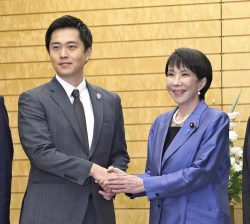G7 Finance Ministers’ Meeting: Measures Urgently Needed to Utilize Frozen Russian Assets
15:50 JST, May 30, 2024
Under attack by Russia, Ukraine is in a difficult situation due to the challenge of procuring arms and ammunition and a lack of funds for reconstruction. It is hoped that the Group of Seven advanced nations will take the lead in hastening the creation of specific support measures.
The recent G7 finance ministers and central bank governors’ meeting that was held in Italy closed with the adoption of a joint statement.
The main topic of discussion at the meeting was how to utilize Russian central bank assets frozen by economic sanctions, which amount to about $300 billion (about ¥47 trillion), to support Ukraine.
Support fatigue for Ukraine is spreading in the West as the crisis becomes protracted. U.S. military assistance was stalled for about six months until an additional budget of $61 billion (about ¥10 trillion) was finally approved in April.
The World Bank estimates that the funds needed for Ukraine’s reconstruction will amount to $486 billion (about ¥76 trillion) over the next 10 years. The challenge going forward will be how to raise these funds.
The cost of infrastructure and other damage caused by Russia’s aggression in violation of international law should fundamentally be compensated by Russia. Utilizing the frozen assets for that purpose can be said to be justified.
About two-thirds of the frozen assets are under the control of European Union countries. The EU agreed on a plan to make use of the frozen assets this month, ahead of the G7 meeting. The plan is to use the proceeds from the cash portion of the frozen assets they hold without touching the principal, including government bonds.
The assets are expected to generate about €3 billion (about ¥500 billion) in annual proceeds. Of this money, the EU intends to use 90% for military assistance and 10% for reconstruction assistance for Ukraine.
However, the EU’s plan alone will not be able to raise sufficient funds for Ukraine. It is essential for the G7 to take the lead in considering a framework to increase the amount of assistance.
The G7 statement “welcomed” the EU’s agreement and summarized that G7 members are “making progress in our discussions.” During the G7 meeting, the United States reportedly proposed a loan on the scale of $50 billion (about ¥8 trillion), with the interest to be generated by the frozen assets in the future as “collateral.”
The U.S. plan has the advantage of being able to provide a large amount of money in a short period of time. However, depending on trends in the financial markets, the expected proceeds might not materialize. It is important for the G7 to use the U.S. proposal as a basis for discussion and scrutinize how much support is possible.
G7 discussions have moved forward because the United States has switched from an asset seizure proposal, which can utilize a larger amount of funds, to the current proposal. The Japanese government had argued that the seizure proposal could violate international law. The G7 statement also stated that utilizing profits stemming from Russian frozen assets should be “consistent with international law and our respective legal systems.”
It is hoped the G7 will carry out thorough discussions so that an agreement can be reached on the issue at next month’s summit.
(From The Yomiuri Shimbun, May 30, 2024)
"Editorial & Columns" POPULAR ARTICLE
-

Artificial Intelligence Expands Possibilities for Foreign Language Learners
-

Build Intellectual, Physical Strength, As Well As Communicative Power / Japan Should Move from Beneficiary to Shaper of World Order
-

Global Economy in Turmoil: Prevent Free Trade System from Going Adrift / Risks to Financial Markets Must Be Heeded
-

Japan-China Strain Set to Persist as Beijing Officials Self-Interestedly Bash Tokyo; Takaichi Unlikely to Back Down
-

French and German Ambassadors to Japan Call for Democracies to Unite in Defense against Russian Disinformation
JN ACCESS RANKING
-

As Chinese Tourists Shun Japan, Hotels and Stores Suffer
-

Osaka-Kansai Expo’s Economic Impact Estimated at ¥3.6 Trillion, Takes Actual Visitor Numbers into Account
-

Japan Govt Adopts Measures to Curb Mega Solar Power Plant Projects Amid Environmental Concerns
-

BOJ Gov. Ueda: Highly Likely Mechanism for Rising Wages, Prices Will Be Maintained
-

Core Inflation in Tokyo Slows in December but Stays above BOJ Target






















